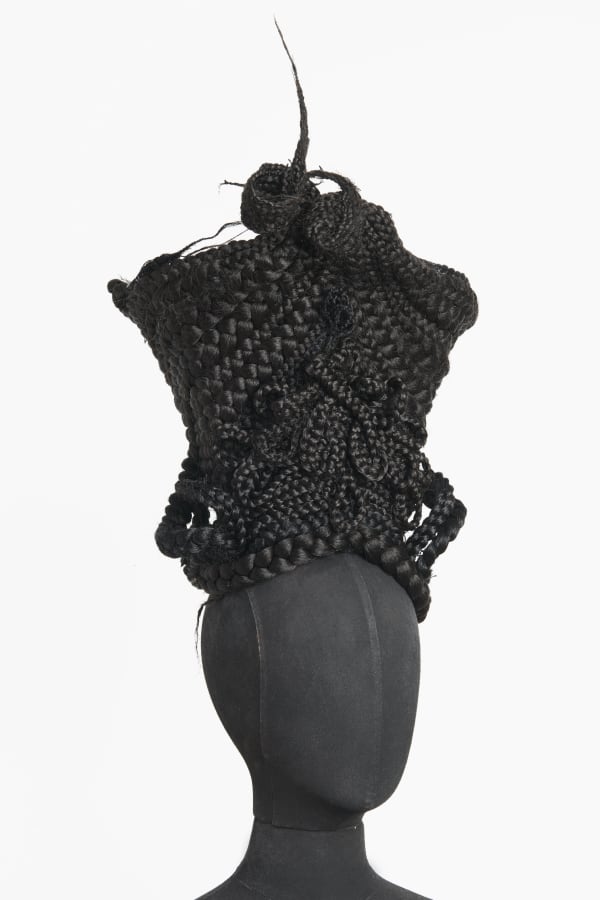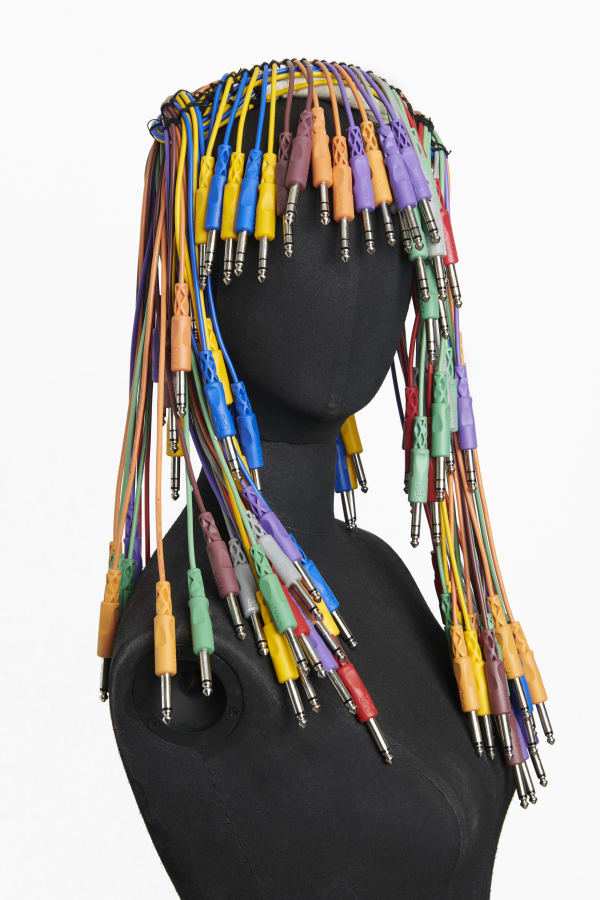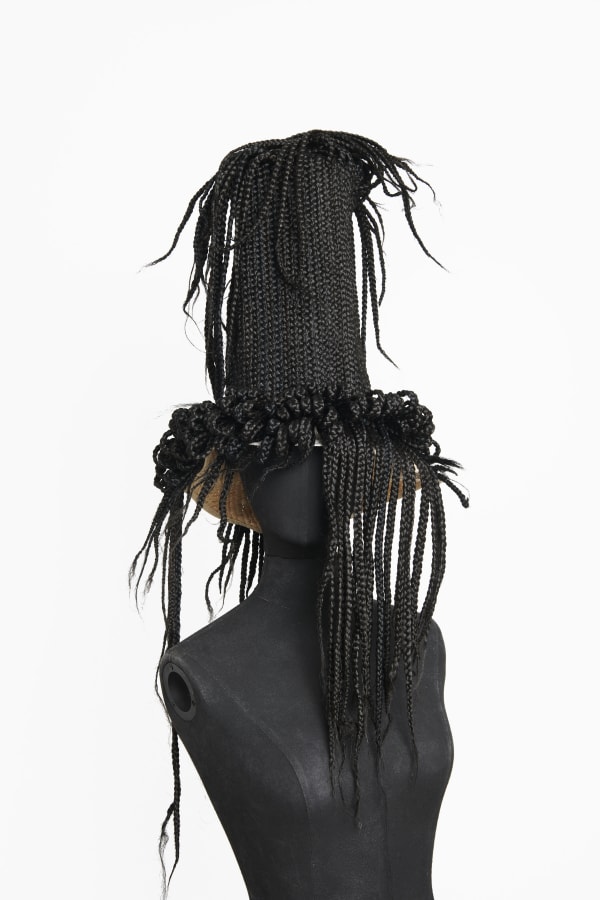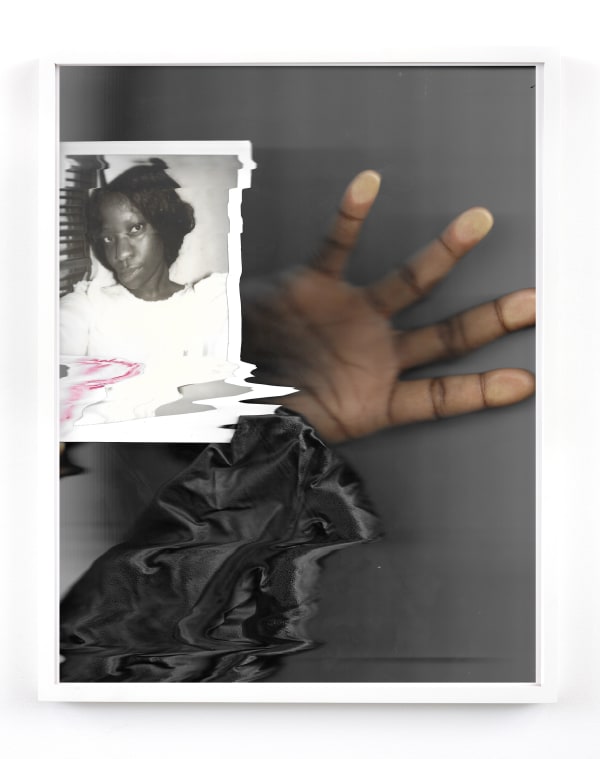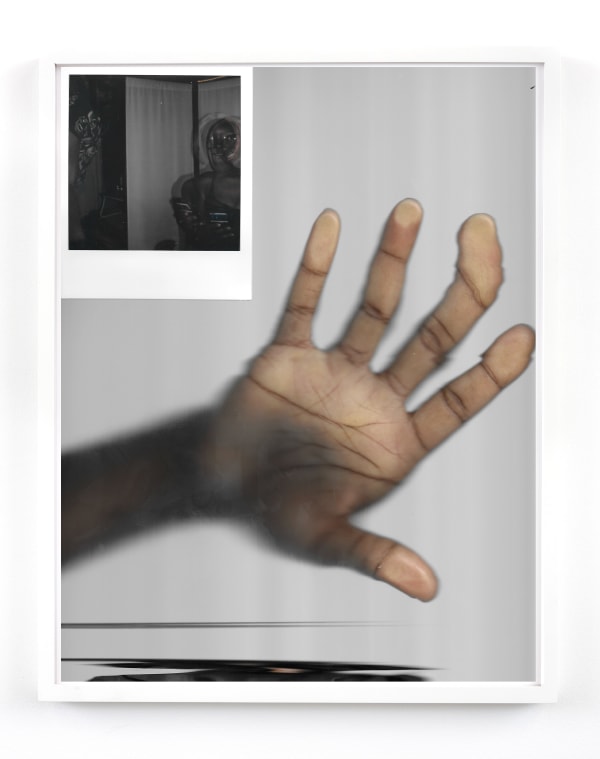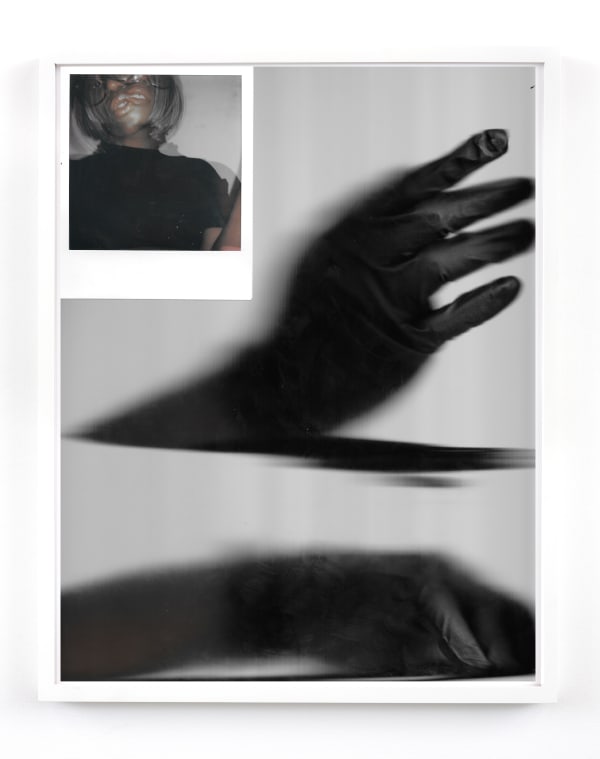-
“Braiding is our history and our future.” – Joanne Petit-Frère
-

-
Drawing on various African Diaspora traditions, the photographs of Cindy Sherman, Haitian history, and a range of other sources, Petit-Frère makes films, drawings and labor-intensive tapestries and sculptures that involve weaving by hand as many as eight or more colors of synthetic hair.
-

-
Joanne Petit-Frère enlists performance as a means by which to think about the body. At a moment in which human touch and presence in society is increasingly charged, Petit-Frère’s artwork reveals human beauty and form, the power of identity, and the shifting currents of social dialogue.
-

-
“We’re in the midst of a major movement now with consciousness of hair types, as well as art and imagery, being pushed to fantastical reaches in the digital era,” Petit-Frère comments.
-

-
Petit-Frère activates their various braided avatars – invented, and often futuristic, entities such as “BraidCora” or “JoGoesWest” – as a way to archive Black history and its varying traditions.
-

-
"In various cultures, the middle of the head is seen as sacred space that is covered or ordained, whether by a yarmulke or a veil,” Petit-Frère comments. “In almost every spiritual tradition it is referred to as the portal to the soul and the most sacred part of the body.” By dedicating each braided crown, mask or bodice to a personal experience or theoretical practice, Petit-Frère creates an artifact for society.
-

-
Petit-Frère's works demonstrate their alignment of their own practice, one rooted in the vernacular of the braid salon, with cultural theory and fine art practices. In works like “Empower Braid Crown (Woven, while reading bell hooks's ‘Rock My Soul’),” or “’She Talks to Beethoven’ Braid Mask (Woven, while catching up on Covid-19 news),” Petit-Frère navigates surrealist literature and the question of self-esteem, in a socially distanced world.
-

-
In negotiating these intellectual silos, Petit-Frère offers profound routes towards thinking about our history, and in doing so, asks us to consider the art object as an active, not passive, tool in advancing how we think about who we are and what we can be. By enlisting a synchronicity in their practice, Petit-Frère cleverly fuses both past traditions and future ideas into an active, diaristic account.
-
Works by Joanne Petit-Frère
Click image to inquire-
 Joanne Petit-Frère, BL + BCN (Blondie + Buccaneer), 2018
Joanne Petit-Frère, BL + BCN (Blondie + Buccaneer), 2018 -
 Joanne Petit-Frère, RS (Rebecca Succubus), 2019
Joanne Petit-Frère, RS (Rebecca Succubus), 2019 -
 Joanne Petit-Frère, STTB + BC (She Talks to Beethoven + BraidCora), 2020-2021
Joanne Petit-Frère, STTB + BC (She Talks to Beethoven + BraidCora), 2020-2021 -
 Joanne Petit-Frère, Bonnet Braid Crown, Visor Edition* (Woven, while Netflix-ing Madame CJ Walker Biopic Series), 2020
Joanne Petit-Frère, Bonnet Braid Crown, Visor Edition* (Woven, while Netflix-ing Madame CJ Walker Biopic Series), 2020 -
 Joanne Petit-Frère, Empower Braid Crown (Woven, while reading bell hooks's "Rock My Soul"), 2020
Joanne Petit-Frère, Empower Braid Crown (Woven, while reading bell hooks's "Rock My Soul"), 2020 -
 Joanne Petit-Frère, Pride Nebular Crown (Woven, while plugging in Bass), 2021
Joanne Petit-Frère, Pride Nebular Crown (Woven, while plugging in Bass), 2021 -
 Joanne Petit-Frère, Braid "Development vs. Disruption" Crown (Woven, fusing eye-protector of ancestor to, eye projection of existing, futurite), 2021
Joanne Petit-Frère, Braid "Development vs. Disruption" Crown (Woven, fusing eye-protector of ancestor to, eye projection of existing, futurite), 2021 -
 Joanne Petit-Frère, Studio Hands #20 - White Lace for Marriage, WHY (Self in Black Gloves for Building Brocades w/ Pink Tips, Ayee), 2020
Joanne Petit-Frère, Studio Hands #20 - White Lace for Marriage, WHY (Self in Black Gloves for Building Brocades w/ Pink Tips, Ayee), 2020 -
 Joanne Petit-Frère, Studio Hands #21 - Listening to Ho99o9 w/ Polaroid Self Portrait in Aritzia Dress (Now Gloves off, I'm Out), 2020
Joanne Petit-Frère, Studio Hands #21 - Listening to Ho99o9 w/ Polaroid Self Portrait in Aritzia Dress (Now Gloves off, I'm Out), 2020 -
 Joanne Petit-Frère, Studio Hands #22 - Being Free w/ Isaiah Panther in Bob King Kitty Effect, 2020
Joanne Petit-Frère, Studio Hands #22 - Being Free w/ Isaiah Panther in Bob King Kitty Effect, 2020 -
 Joanne Petit-Frère, Studio Hands #23 (Jordan's No.) - BraidCora Weaves Elegance, See These Fingahs (Black Gloves, Black Fit Tee, Black Dip Dyed Bob- Bassed, Blessed? Yes), 2020
Joanne Petit-Frère, Studio Hands #23 (Jordan's No.) - BraidCora Weaves Elegance, See These Fingahs (Black Gloves, Black Fit Tee, Black Dip Dyed Bob- Bassed, Blessed? Yes), 2020 -
 Joanne Petit-Frère, (Fin) Studio Hands #24 of BraidCora Quarantina PT1 - Black Braid Brocade (With Love, Signing off), 2020
Joanne Petit-Frère, (Fin) Studio Hands #24 of BraidCora Quarantina PT1 - Black Braid Brocade (With Love, Signing off), 2020
-
-
Press Release
Philip Martin Gallery is proud to present “BraidCora 33,” an exhibition of new braided sculptures by New York-based artist, Joanne Petit-Frère. Often activated by performance, Petit-Frère’s work addresses the human body as a site of beauty and adornment.
Drawing on various African Diaspora traditions, the photographs of Cindy Sherman, Haitian history, and a range of other sources, Petit-Frère makes films, drawings and labor-intensive tapestries and sculptures that involve weaving by hand as many as eight or more colors of synthetic hair. Joanne Petit-Frère enlists performance as a means by which to think about the body. At a moment in which human touch and presence in society is increasingly charged, Petit-Frère’s artwork reveals human beauty and form, the power of identity, and the shifting currents of social dialogue. “We’re in the midst of a major movement now with consciousness of hair types, as well as art and imagery, being pushed to fantastical reaches in the digital era,” Petit-Frère comments.
Petit-Frère activates their various braided avatars – invented, and often futuristic, entities such as “BraidCora” or “JoGoesWest” – as a way to archive Black history and its varying traditions. "In various cultures, the middle of the head is seen as sacred space that is covered or ordained, whether by a yarmulke or a veil,” Petit-Frère comments. “In almost every spiritual tradition it is referred to as the portal to the soul and the most sacred part of the body.” By dedicating each braided crown, mask or bodice to a personal experience or theoretical practice, Petit-Frère creates an artifact for society. “Braiding is our history and our future,” Petit-Frère writes.
Petit-Frère's works demonstrate their alignment of their own practice, one rooted in the vernacular of the braid salon, with cultural theory and fine art practices. In works like “Empower Braid Crown (Woven, while reading bell hooks's ‘Rock My Soul’),” or “’She Talks to Beethoven’ Braid Mask (Woven, while catching up on Covid-19 news),” Petit-Frère navigates surrealist literature and the question of self-esteem, in a socially distanced world. In negotiating these intellectual silos, Petit-Frère offers profound routes towards thinking about our history, and in doing so, asks us to consider the art object as an active, not passive, tool in advancing how we think about who we are and what we can be. By enlisting a synchronicity in their practice, Petit-Frère cleverly fuses both past traditions and future ideas into an active, diaristic account.
Joanne Petit-Frère (b. 1987, New York, NY) received a BA from the Fashion Institute of Technology (New York, NY). Their work is currently featured in "From the Limitations of Now" at Philbrook Museum of Art (Tulsa, OK). In 2020, Petit-Frère’s work was the subject of two solo exhibitions: “Black Braid Brocade,” at Philip Martin Gallery (Los Angeles, CA), and BRAID.CORA QUARANTINA 2020 (POST.JUNETEENTH), commissioned by the California African American Museum (Los Angeles, CA) and Los Angeles Nomadic Division (Los Angeles, CA). Petit-Frère’s work will be featured in an upcoming solo project on Gondola. Recent group and museum shows include, “A Queen Within: Adorned Archetypes,” at the Museum of Pop Culture (Seattle, WA); and “This Synthetic Moment (Replicant),” curated by David Hartt at Philip Martin Gallery (Los Angeles, CA). Petit-Frère’s work has been included in performances and exhibitions at MoMA PS1 (New York, NY); New Museum (New York, NY); Haitian Cultural Exchange (New York, NY); New Orleans Museum of Art (New Orleans, LA); and The Ethelbert Cooper Gallery of African and African American Art, Harvard University (Cambridge, MA). Petit-Frère has created custom hair sculptures for Beyoncé, Solange Knowles, Les Nubians, and Janelle Monáe, among others. Petit-Frère’s work has been featured in publications such as Artforum, Vogue, Vogue Italia, Vogue Japan, The New Yorker, The Evening Standard, AnOther Magazine, and Cultured Magazine. Her work is in the collection of such public institutions as the Philbrook Museum of Art (Tulsa, OK). Petit-Frère lives and works in New York, NY.
Joanne Petit-Frère’s exhibition is on-line through August 4, 2021. Kristy Luck’s exhibition of new oil-on-linen paintings is on view at the gallery through August 14, 2021.
Philip Martin Gallery is open Tuesday - Saturday from 10-4 and by appointment. Pre-scheduled appointments are available, and walk-ins are welcome. To make an appointment, or to get additional images, or information please email info@philipmartingallery.com, or call 310-559-0100. Philip Martin Gallery is located at 2712 S. La Cienega Blvd, Los Angeles, CA 90034 in the Culver City area of Los Angeles between Venice Blvd. and Washington Blvd., just south of the 10 Freeway.
-
To inquire about works by Joanne Petit-Frère, click here
Joanne Petit-Frère: BraidCora 33
Past viewing_room











